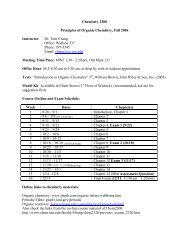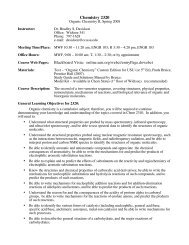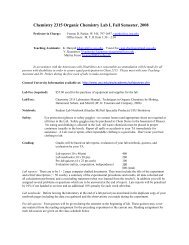Organic Chemistry I
Organic Chemistry I
Organic Chemistry I
You also want an ePaper? Increase the reach of your titles
YUMPU automatically turns print PDFs into web optimized ePapers that Google loves.
<strong>Chemistry</strong> 2310<strong>Organic</strong> <strong>Chemistry</strong> I, Fall 2008Instructor:Dr. Bradley S. DavidsonOffice: Widtsoe 341Phone: 797-1628e-mail: brad.davidson@usu.eduMeeting Time/Place: MWF 10:30 – 11:20 am, Eccles Business 215; R 3:30 – 4:20 pm, Old Main 225Problem Session (optional): TBAOffice Hours:MWF, 9:00 – 10:00 am; T, 1:30 – 2:30; or by appointmentCourse Web Pages: BlackboardMaterials:Text – "<strong>Organic</strong> <strong>Chemistry</strong>," Paula Yurkanis Bruice, Prentice Hall. USU Custom Ed or 5 th Ed(2007).Study Guide and Solutions Manual by Bruice.Model Kit – Available in Chem Stores (1 st floor of Widtsoe). (recommended)Tentative Course Outline and Exam Schedule:Week Dates Quiz Chapter(s)one 8/25 – 8/29 Pre Introduction, Chapter 1two 9/3 – 9/5 1 Chapter 1three 9/8 – 9/12 2 Chapter 2four 9/15 – 9/19 3 Chapter 3five 9/22 – 9/26 Review (9/22), Exam 1 (9/24), Chapter 4six 9/29 – 10/3 4 Chapter 4, Chapter 5seven 10/6 – 10/10 5 Chapter 5, Chapter 6eight 10/13 – 10/16 Chapter 6, Review (10/15), Exam 2 (10/16)nine 10/20 – 10/24 6 Chapter 7ten 10/27 – 10/31 7 Chapter 7, Chapter 8eleven 11/3 – 11/7 8 Chapter 8, Chapter 9twelve 11/10 – 11/14 Chapter 9, Review (11/13), Exam 3 (11/14)thirteen 11/17 – 11/21 9 Chapter 10fourteen 11/24 10 Chapter 10fifteen 12/1 – 12/5 11 Chapter 11, Review (12/5)sixteen 12/8 Final Exam (9:30 – 11:20 am)
Assessment:Assessment involves measuring student progress as well as teaching effectiveness. The followingassessment strategies have been incorporated into this course.• A pre-test/post-test approach will be used to measure comprehension and teaching of importantconcepts. The pre-test will be administered through Blackboard and must be taken on your own time.The fifteen multiple choice questions of the pre-test will reappear in the final, in slightly altered form,to assess teaching and learning progress during the semester. If weaknesses are observed in specificsubject areas, teaching methods will be reevaluated. Although no formal points will be awarded, youmust take the pre-test before you will be permitted to take course quizzes.• Student evaluations will be used to evaluate course/instructor strengths and weaknesses. In additionto the standard end-of-course evaluation, a midterm questionnaire will be circulated to assessteaching/learning strategies. Constructive suggestions are welcome anytime.General Learning Objectives for 2310• Be able to describe atomic and molecular structure and bonding, and properly represent organicmolecules.• Be able to classify organic compounds by structure, use the IUPAC nomenclature, and identifyconformational effects in organic compounds.• Be able to write the mechanisms for reactions of alkenes and be able to predict the products ofreactions of alkenes.• Be able to draw and interpret reaction coordinate diagrams, and be able to relate the energetic changesassociated with chemical reactions to equilibrium constants and rate; be able to differentiate kineticversus thermodynamic control of reactions.• Be able to identify the types of isomerism in organic compounds, to identify and classify chiralcenters, and explain the physical and chemical consequences of chirality.• Be able to correctly represent the structures and bonding of alkynes, and be able to write themechanisms for reactions of alkynes and predict the products of such reactions.• Be able to identify compounds in which resonance is important, to predict the effect of resonance onthe stability of compounds and reactive intermediates, and be able to draw resonance structures.• Be able to identify conjugated pi systems and to explain the effect of conjugation on molecularstructure and reactivity; be able to predict the products of reactions of dienes.• Be able to write the mechanism for radical reactions of alkanes, and to predict the products of suchreactions.• Be able to write mechanisms for substitution and elimination reactions, and to predict the effect ofnucleophile, leaving group, and solvent on the relative rates of S N1 versus S N2 reactions, and E1 versusE2 reactions, as well as on the relative rates of substitution versus elimination.***Detailed learning objectives for each chapter are available on the Blackboard website.Online links to chemistry materials:• Bruice textbook website (4 th edition). Do the tutorials for each chapter.wps.prenhall.com/esm_bruice_organic_4/
• Jones and Bartlett Publishers' organic chemistry site, which has files of molecular structures,animations of chemical mechanisms, and much more: www.jbpub.com/organic-online/webhome.htm• A site with self-tests, message boards, and other helpful organic chemistry study aids:www.chemhelper.com• Virtual textbook of organic chemistry: www.cem.msu.edu/~reusch/VirtualText/intro1.htm• Web-sters' <strong>Organic</strong> <strong>Chemistry</strong> is a site that has numerous organic chemistry study aids and links toother helpful sites: Chemconnections.llnl.gov/Websters• Curly Arrows site has mechanism tutorials: www.abdn.ac.uk/curly-arrows/index.shtml• Los Alamos Periodic Table Site: pearl1.lanl.gov/periodicGrading Scheme:Point Distribution:Best two out of three one-hour exams (2 100 pts)Best ten out of eleven Blackboard quizzes (10 10 pts)Comprehensive Final (200 pts)Total Points: 500 ptsGrade Breakdown:The grade received in the course is based on your performance on the exams, quizzes, andhomework. Grades are guaranteed as given below for overall percentage score on all exams. Actualgrade ranges may be curved somewhat lower, depending on the overall class average.Procedures:A, A- 89% or higherB+, B, B- 78% or higherC+, C, C- 66% or higherD+, D 53% or higher1. The format of the exams is a combination of multiple choice (30%) and fill-in (70%), where youwill be expected to draw chemical structures and explain you answers. The exams are meant totest your understanding of the topics covered in lecture, not your ability to repeat memorizedproblems. Expect some questions that require you to apply your understanding to new problems.Practice problems and past exams will be available on the Blackboard site for download. Theywill provide the best examples of the fill-in questions.2. There will be no make-up exams. It is possible to take an exam in advance, but only with a validexcuse and prearrangement with me. If you miss an exam without prearrangement, then that willbe the exam dropped from your overall score.3. Addition mistakes or questions over exam grading should be discussed with me within one weekfollowing the return of the exam. No point adjustments will be made after this time.4. Quizzes will be offered through Blackboard (online.uen.org/webct/entryPage.dowebct) and mustbe taken on your own time. Each quiz will be available from Monday, 10:30 am (MST), until thefollowing Monday, 10:30 am. They will consist of ten multiple-choice questions, chosenrandomly from a bank of questions. They will be open-book, with a time limit of 30 minutes, andcan be taken as many times as you want, with your highest score being recorded. You will benefitthe most from the quizzes if you prepare and try to take them without help from the book or yournotes.5. All answer keys, practice tests, lists of assigned problems, etc. will be posted on the courseBlackboard site. Answer keys and practice tests will be available in pdf format, which will require
you to have Adobe Acrobat Reader on your computer. This can be downloaded free atwww.adobe.com/products/acrobat/readstep2.html.6. It is official University policy that unless you have three exams on the same day, you must takethe final exam in this course at the officially scheduled time. Permission to take a final at anyother time for any other reason can only be obtained from the Dean of Science.7. The University add/drop policies are described in the Fall Schedule of Classes on pages 104 –109. August 31st is the last day to add a class without an instructor's signature; students may addcourses between September 2nd – 15th only with the instructor's signature. The last day to add isSeptember 15th. Page 107 describe the drop policy. In short, a student may drop a class withoutany notation on the transcript until September 15th (the first 20 percent of the class). After thatdate, any drop receives a permanent "W" notation on the transcript. After 60 percent of a class iscompleted (October 28th), the advisor (not the Dean's Office) must approve of a drop. Inaddition, the "W" is accompanied by the grade in the class at the time of the drop. Finally, after75% of a class is completed (November 13th), a student may not drop a class for any reason. TheUniversity policy on giving a grade of Incomplete will be strictly followed. See the section onAcademic Policies in the Fall Semester Schedule of Classes guide, pages 104 – 109, for currentpolicies.8. The main function of office hours is to discuss and solve problems that you may be having withthe course materials, assigned problems, and concepts presented during lecture. Try to formulatequestions in advance. Do not expect a mini review session.9. All individuals are responsible for understanding the contents of this document.10. Students with ADA-documented physical, sensory, emotional, or medical impairments may beeligible for reasonable accommodations. Veterans may also be eligible for services. Allaccommodations are coordinated through the Disability Resource Center (DRC) in Room 101 ofthe University Inn, (435)797-2444 voice, (435)797-0740 TTY, or toll free at (800)259-2966.Please contact the DRC as early in the semester as possible. Alternate format materials (Braille,large print or digital) are available with advance notice.Suggestions:1. Try not to simply memorize. You will be more successful if you strive to understand theunderlying principles.2. Organize your reactions. Categorize them by reacting functional group, reagent, and productfunctional group. Look for similarities in mechanism.3. Make up flash cards with reagents on one side and products on the other and with organic andinorganic reagent on one side and organic reagent and product on the other. Drill yourself.4. Keep up with lecture and reading materials.5. Make sure to take the quizzes and do the on-line homework problems! In addition to helpingyour overall comprehension and exam performance, do not miss easy-to-obtain points.6. Work the problems! Work the problems! Work the problems! (practice makes perfect)7. Use the web sites listed above.8. Study in groups, but make sure everyone contributes.9. Use molecular models and/or the textbook website to visualize the three-dimensional nature oforganic molecules.
















